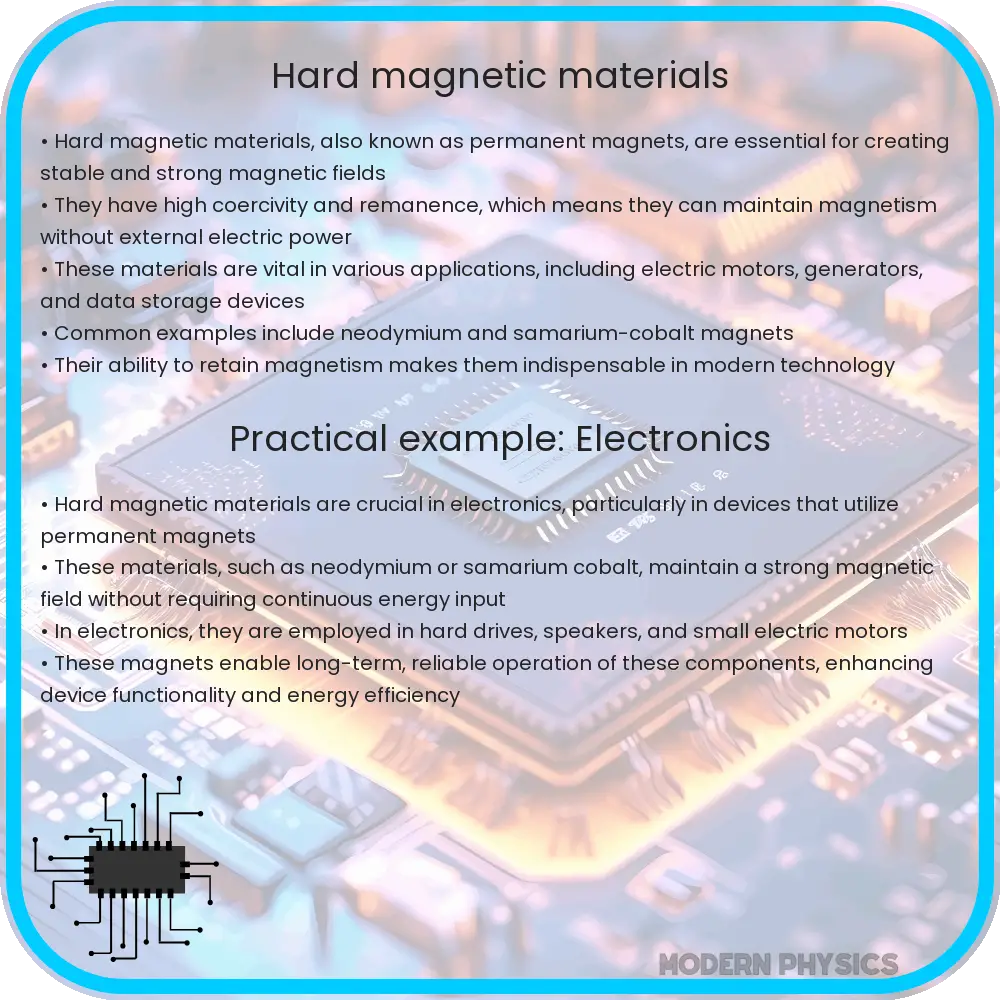Explore the world of hard magnetic materials, their durability, coercivity, and diverse applications in technology and industry.

Understanding Hard Magnetic Materials
Hard magnetic materials, also known as permanent magnets, are crucial in various industrial and technological applications due to their ability to maintain a stable magnetic field without an external power source. These materials are characterized by their high coercivity, meaning they can withstand demagnetization when exposed to external magnetic fields. This article explores the durability, coercivity, and use cases of hard magnetic materials.
Durability of Hard Magnetic Materials
The durability of hard magnetic materials is a key factor in their widespread use. These materials are designed to sustain their magnetic properties under a range of environmental conditions, including temperature fluctuations, corrosion, and physical wear and tear. The durability is often enhanced through material composition and protective coatings, ensuring longevity in various applications.
Coercivity in Hard Magnetic Materials
Coercivity is a measure of the resistance of a ferromagnetic material to becoming demagnetized. Hard magnetic materials exhibit high coercivity, which is essential for their function as permanent magnets. The coercivity of a material is determined by its microstructure and composition. Alloys such as Neodymium-Iron-Boron (Nd2Fe14B) and Samarium-Cobalt (SmCo5 or Sm2Co17) are notable for their high coercive forces.
Use Cases of Hard Magnetic Materials
- Electronics and Computing: Hard magnetic materials are integral in the manufacturing of hard disk drives, speakers, and various sensors.
- Automotive Industry: The demand for efficient and compact motors in electric vehicles has increased the use of hard magnets in the automotive sector.
- Renewable Energy: Wind turbines and other renewable energy technologies rely on permanent magnets for power generation.
- Medical Devices: Advanced medical equipment, such as MRI machines, utilizes hard magnetic materials for their powerful and stable magnetic fields.
This overview of hard magnetic materials highlights their significance in modern technology and industry. Their unique properties, such as high coercivity and durability, make them indispensable in numerous applications. Understanding these materials is key to innovating and advancing in fields ranging from renewable energy to medical technology.
Advanced Developments in Hard Magnetic Materials
Recent advancements in material science have led to the development of new hard magnetic materials with enhanced properties. Innovations in processing techniques, such as rapid solidification and powder metallurgy, have allowed for finer control over the microstructure of these materials, resulting in improved magnetic performance. Additionally, research into rare earth-free magnets offers potential for more sustainable and cost-effective alternatives, addressing the environmental and economic concerns associated with rare-earth elements.
Challenges and Future Perspectives
Despite their many advantages, hard magnetic materials face challenges, particularly in terms of resource dependency and environmental impact. The extraction and processing of rare-earth elements, crucial for many high-performance magnets, pose significant environmental challenges. Furthermore, the geopolitical concentration of these resources raises concerns about supply stability. Ongoing research aims to address these issues by developing more sustainable materials and recycling strategies to reduce dependency on virgin materials.
Emerging Applications of Hard Magnetic Materials
- Aerospace Industry: The aerospace industry is increasingly adopting hard magnetic materials for various applications, including actuators and satellite components.
- Robotics: Robotics systems utilize permanent magnets in motors and sensors, enhancing efficiency and precision.
- Consumer Electronics: The miniaturization trend in consumer electronics continues to drive demand for small yet powerful magnets.
Conclusion
Hard magnetic materials play a pivotal role in numerous contemporary technologies and industries. Their unique characteristics, such as high coercivity and durability, make them indispensable in a wide range of applications, from everyday electronics to cutting-edge medical and renewable energy technologies. The ongoing research and development in this field promise to overcome current challenges and open up new possibilities, including more sustainable and efficient materials. As we move forward, the continued innovation in hard magnetic materials is essential for technological advancement and environmental sustainability, making them a key focus for future scientific and industrial endeavors.
